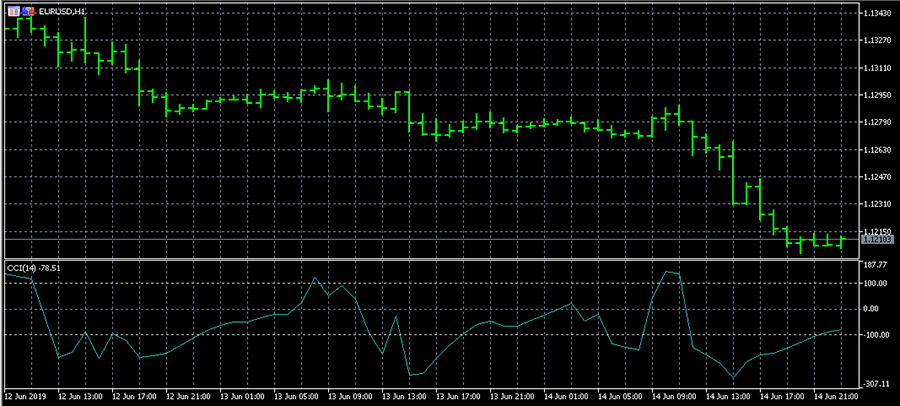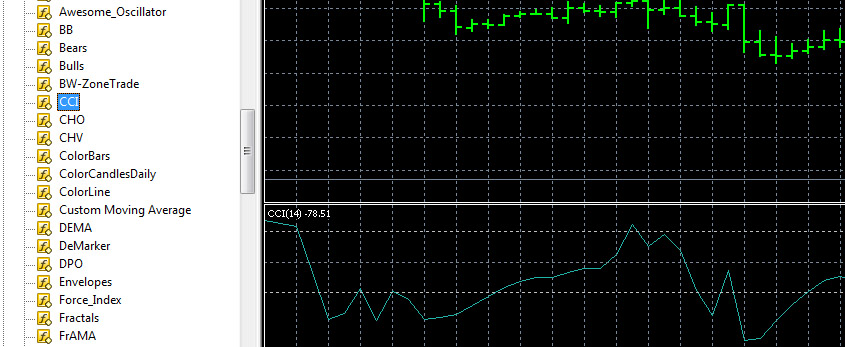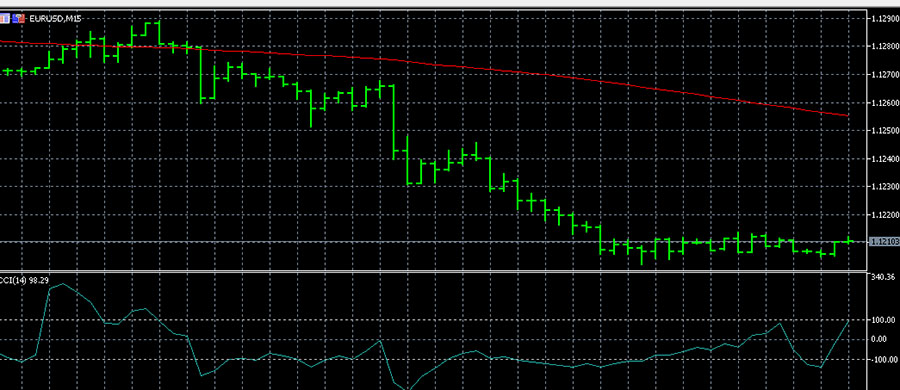CCI (Commodity Channel Index) Oscillator
Contents
Description of the CCI oscillator
The Commodity Channel Index (CCI, Figure 1) was developed by trader Donald Lambert in the 1980s to identify reversals in the commodities market. Later it turned out that the CCI is also good for forex trading. Lambert proposed this indicator for work on the assumption that the price changes cyclically.
Image. 1
The CCI has a variety of applications: it can be used to identify overbought and oversold levels, it can be used to identify turning points, highs and lows in prices. Its functions forex oscillator performs by counting the deviations of its line from the moving average, that is, from the statistical average price. Therefore, its high values indicate that the price is overvalued relative to the average, and its low values indicate that it is undervalued relative to the average.
| Broker | Bonuses | Open an account |
|---|---|---|
|
1
|
50 %
Bonus on deposit from $100 USD – promo code WELCOME50
|
Start |
|
2
|
From 25 To 60 %
Deposit increase for the first deposit
|
Start |
|
3
|
Cashback
Refunds of commissions, spreads and other costs
|
Start |
|
4
|
100 USD
Loyalty program remuneration
|
Start |
|
5
|
20 %
Bonus and cashback by promo code revieweek23
|
Start |
It is believed that the CCI is more effective on a sideways flat than on a clear trend. It is also a common opinion that the optimal timeframe for the oscillator is 1H. If it shows a dynamic growth between 0 and 100 it is an evidence of a strong uptrend, if it is quickly falling below 100 it is a strong downtrend.
The CCI monthly, weekly and daily indicators differ in accuracy. For example, the CCI monthly and weekly indicators allow you to more accurately identify the periods when positions are opened and closed. The operation of the CCI on a daily interval requires additional indicators for forexThe CCI may miss strong signals in a volatile market. CCI can be used to markup support and resistance levels and trend lines.
Calculation formula
CCI is a line, which fluctuates between +300 and -300, although this oscillator actually has no limitations, so the values can be either less than -300 or more than +300. But most of its values are between +100% and -100%. Values that go beyond these limits are evaluated as non-random and can be the reason for opening positions.
The time interval is the most important parameter for calculating the CCI, which largely determines the accuracy of its indicators. Traders mainly use the interval preset in the oscillator, but it is recommended to calculate it accurately each time you use the tool, because it will significantly reduce the number of false indicators. Forex signals.
To determine the interval, you need to open the daily chart of the indicator, identify two highs and two lows, the time period between them, – this will be the length of the cycle. One third of this cycle will be the optimal time interval to use for the CCI.
The commodity channel index is calculated using the following formula:
CCI = (0.015 x default deviation)/(typical price – SMA), where:
- “Typical price” is the arithmetic average of the maximum, minimum and closing prices;
- The SMA is based on typical prices for a certain period;
- 0.015 is a constant that was calculated empirically;
- The default deviation is the SMA, plotted against the “typical price – SMA” value.
CCI Oscillator in the MetaTrader 5 Platform
The trading channel index can be called a classical oscillator, so it is preinstalled in the terminals of popular trading systems. In particular, in MT5 it is located in the navigation toolbar on the left (Fig. 2):
Image. 2
CCI oscillator signals
Donald Lambert in his description of the Commodity Channel Index suggested the following concept of his signals: if up to 80% the oscillator values are between -100 and +100 (Fig. 3), then the buy and sell signals can only be generated around 20% of the monitored period:
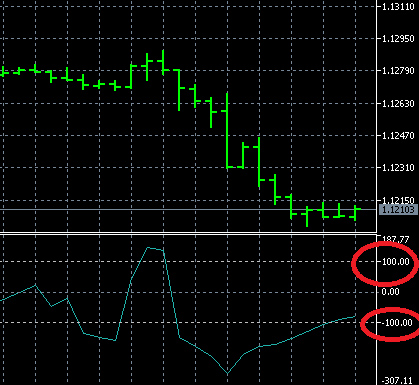
Image. 3
Other popular CCI signals include crossovers. When the indicator crosses the +100 level from bottom to top, it means the beginning of an uptrend and is interpreted as a buy signal. When it crosses -100 from above downwards, it indicates the beginning of a strong downtrend and is a sell signal.
CCI is used to work on divergences. Two consecutive oscillator lows above -100 are monitored. If the second low is higher than the first but lower than the first price low, it is a positive divergence and confirms the price crossing -100 from bottom to top.
Two consecutive CCI highs above +100 are tracked. If the second high is below its first high, but above the price high, it is a negative divergence, which confirms the signal of a +100 cross downwards.
Another signal is when the CCI is above +200 (Fig. 4), which warns against opening a buy position, because once it reaches this level, the trend weakens. Conversely, sell positions should not be taken if the CCI exceeds +100 and continues to move, thus indicating that the trend is stable.
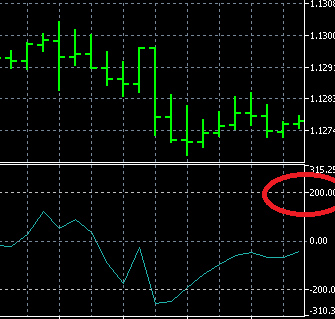
Image. 4
Also on the CCI indicator you can mark the graphical patterns: head and shoulders, triangles and others.
Trading strategies based on the CCI oscillator
Forex Strategies There are many trading strategies implemented with the help of the CCI oscillator, from the use of only one indicator to multi-indicator systems. The strategy for a single CCI is to buy on a new high above +100 and to open a sell position on lows below -100. In the first case, trades are entered when the new high exceeds the previous high, in the second case, after the formation of a new low below the previous low.
The CCI is often used in conjunction with a moving average (Figure 5). To implement one of these strategies, a CCI and a simple moving average with a period of 100, which in this case acts as support and resistance, are placed on the chart. The strategy is implemented on timeframes from M5 to M15, on the bounce of the moving average from the price.
Image. 5
Buy positions are opened when the CCI exits the oversold zone and the price crosses the MA from bottom to top. Sell positions are opened when the indicator exits the overbought zone and the price crosses the moving average.
The other strategy uses three classic tools – CCI, MACD and Parabolic SAR (Fig. 6). Recall that MACD (Moving Average Convergence/Divergence) can be called a trend oscillator, it is used to determine the trend direction and reversal points. Parabolic SAR is used to determine trend reversal on a pronounced trend.
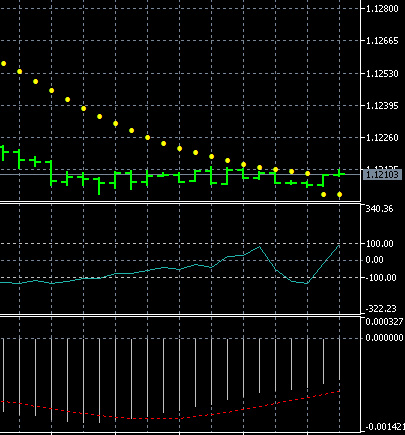
Image. 6
The signal to sell will be an exit of the CCI from the overbought zone to a level below +100, crossing of the MACD line and placement of the Parabolic SAR above the chart. On the contrary, the signal to buy will be an exit of the CCI from the oversold area to the level above -100, crossing of the MACD line and placement of the Parabolic SAR under the chart.
In another strategy together with the CCI indicator is used RSI. Recall that RSI (relative strength index) is a relative strength index, which shows the strength of the trend and the probability of its change. In the CCI settings the levels -100 and +100 are deleted, the interval is limited by the levels -30 and +30. In the RSI parameters the calculation is changed to Weighted Close (Fig. 7).
Signal to buy – when CCI crosses from bottom to top RSI in -30 range, respectively, signal to sell – when CCI crosses from top to bottom RSI in +30 range. The specified parameters are not obligatory, the trader should find the settings he needs according to the asset he trades.
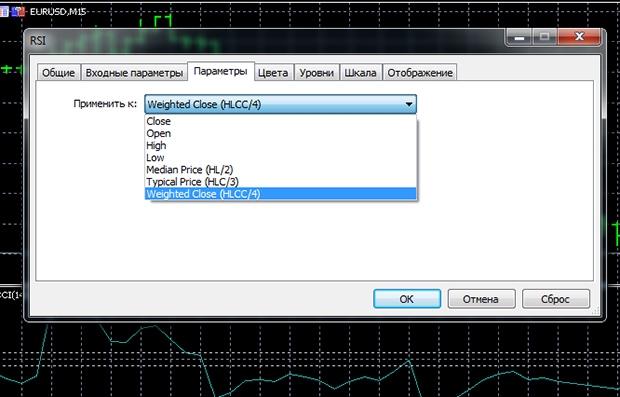
Image. 8
To these two indicators we can add Stochastic to implement another strategy on the timeframe of M15 and above. The technique adds -100 and +100 levels to the CCI indicator. The levels 35 and 65 are added to the RSI. On the Stochastic, 80 and 20 levels are applied, the signal line values are excluded.
Buy positions are opened when Stochastic crosses the 20 level upwards, the CCI and RSI exit the oversold zone with upward crossovers of -100 and 35, respectively. Sell positions are opened when Stochastic crosses the 80 level downwards, the CCI and RSI come out of the overbought zone, crossing downwards through +100 and 65, respectively. The strategy is not implemented in case of a strong trend, as indicators may give contradictory and false signals.
CCI can be used in a strategy with Laguerre indicator (you can download it here https://www.mql5.com/ru/market/product/14831) and exponential moving average EMA. In this case the CCI is set with a period of 14 and the levels +5 and -5. Laguerre indicator parameters – 1, 0.9, 0.1, 0. EMA period – 120.
Buy position opening is performed when CCI is placed below -5, EMA is directed upwards, Laguerre shows 0.3. Positions to sell are opened when EMA is directed downward, Laguerre indicator shows 1, CCI is placed above +5.
CCI is used in a multi-indicator strategy with Bollinger Bands, indicator ZigZagThe Bollinger bands, ZigZag Pointer and Stochastic (Fig. 8). Bollinger bands and regular ZigZag are pre-installed in the trading terminals, ZigZag Pointer will need to be found in third-party sources and downloaded, making sure the files are safe.
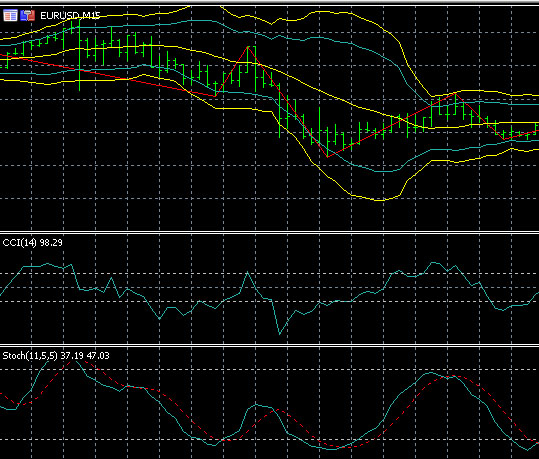
_
The Bollinger Bands are set with the parameters 20.2 and 20.3. The ZigZag indicator is set with the parameters 12, 5, 3, its modification – ZigZag Pointer (you can download it here https://www.mql5.com/ru/code/7401 for example) – with the parameters 10, 5, 15. ZigZag can be applied without the support of the modified version, but ZigZag Pointer makes the strategy more effective. Stochastic settings: 11, 5, 5. CCI settings are standard, but additional -90 and +90 levels are added to it.
Buy positions are opened when the price crosses the lower Bollinger band of 20.3, both ZigZag indicators must mark the breakout price, Stochastic must be below the 20 level and CCI – below -90. Sell positions are opened when the price breaks through the Bollinger Band with parameters 20.3, with ZigZag and ZigZag Pointer marking the breakout point, Stochastic is placed above 80, and the CCI line is above the 90 level.
Conclusions
Commodity Channel Index is a classic tool of tehanalysis, an effective and reliable oscillator, which is very popular among traders. It effectively identifies extremums, oversold and overbought, reversals, most accurately shows market entry points (The whole truth about forex).
One of its disadvantages is that during a strong trend the CCI moves from overbought to oversold too quickly, so there is a risk of getting the trend reversal signal wrong. Therefore it is optimal to use CCI with other indicators, using it in addition to all its other functions as a filter of false signals of indicators.
